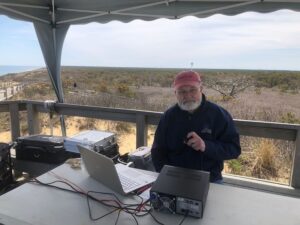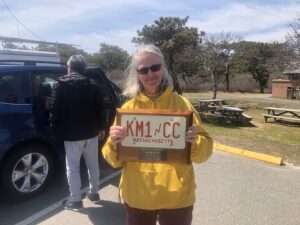WELLFLEET — About a dozen ham radio operators were here on April 27 to mark the 150th birthday of Guglielmo Marconi. It wasn’t really the inventor’s birthday — that’s April 25 — but the Cape Cod Marconi Club gets together at the Marconi site every year on the Saturday that falls closest to that anniversary.

The day that matters to club members is arguably not the birthday of the experimenter, spiritualist, and self-described nonscientist who won a Nobel prize in physics, then ended up joining the Fascist Grand Council under Benito Mussolini. No one mentioned Marconi’s strange personal history.
One could argue that the date this group gathers to celebrate is actually Jan. 18, 1903 — the day Marconi sent the first radio transmission from North America to England. Ham radio enthusiasts, also known as amateur radio operators, use much the same technology that Marconi discovered to communicate with listeners around the globe today.
The Cape Cod Marconi Club is an informal organization of enthusiasts from across Cape Cod and New England. Those who turned out had come from far and wide — one traveled from Bushkill, Pa. for the day.
It shouldn’t really be a surprise that a ham operator would drive six hours to stand in a parking lot by the ocean and listen to the radio. Ham radio is an addictive hobby, said Barbara Dougan of Sandwich, a trustee of the club. “I’ve never been quite so captivated by an activity or hobby in my life,” said Mindy Hull, who was here from Boston.
The Marconi Station’s original radio towers are long gone, but for the celebration, four antennas were temporarily raised at the original site. In the parking lot, Rick Pendleton operated a ham radio with two antennas from the back seat of his car; closer to the beach, Hull attached a transmitter to a kite, flying it as Marconi had done during an experiment; and atop a dune, Barry Hutchinson sent out his signal while gazing at the ocean.
Rick Pendleton has been a ham, he said, since the ’60s. He drove down from Braintree for this gathering with a full radio rig in his car; an informal plywood console carries transmitters in his back seat. (His rig is so portable that he said he brought it to Aruba once, stowing it in the overhead compartment). He spent the morning making contact with hams from Switzerland, Russia, Hungary, and Germany.

“When I started, in the ’60s, it was all about simply communicating with the world,” Pendleton said. “The only way to communicate was by mail. But then I bought a shortwave radio, and all of a sudden I could hear international radio, like Radio Moscow, Radio Peking.”
For Pendleton, ham radio was his “internet” back then. It was a way of meeting the world from his home in Braintree, and ever since then he sits down at the radio every day. Tapping out Morse code over the airwaves is second nature to him, even faster than typing a message on a computer.
He has friends from across the world, people he talks with “about the weather, about college, about what they’re having for dinner that night.”
Before the system of logging contacts was digitized, ham radio operators would collect QSL cards, written confirmations that two-way communication has been established. Pendleton has a collection of more than 30,000 such cards.
Every ham radio operator at the Marconi site that day wanted to share the stories of the faraway friends they had made in their years on the air. Pendleton said he had spoken with a man for years by Morse code only to finally meet him in person at a convention in Marlborough and learn that his radio friend was blind — the subject had never come up. Dougan brought up a radio friend she made on Cape: “He was a spy in World War II, flying in airplanes all over Europe intercepting messages on the radio,” she said.
To become a ham radio operator, Pendleton said, means passing two Federal Communications Commission exams. Then it’s only a matter of getting familiar with Morse code, setting up your equipment, and making friends.
A small crowd gathered around Hull as she fiddled with her kite radio. It wasn’t a particularly windy day, and the radio kept nose-diving into a pitch pine below.

“This is a very sketchy radio,” said Hull. “We’ve only reached Florida, North Carolina, Indiana, I think maybe Arkansas.” But, she said, “It’s experimental, and so fun.”
Zach Piotrowski, the ham from Bushkill, watched as Hull’s kite rose above the onlookers. He first got interested in ham radio because he spends a lot of time in national parks. There, he’d encounter radio operators associated with Parks on the Air, a group of amateurs devoted to emergency preparedness in the parks.
“I realized that most people operate from their basements, so they’re caged by these walls,” Piotrowski said. “Being able to get outside is just prettier.”
Among the hams in attendance, Hutchinson certainly had the best view. Overlooking the Atlantic, he said he was reminded of the sinking of the Titanic in 1912. He recounted how 700 passengers were saved from drowning because the ship’s distress calls happened to be picked up by a Marconi Company radio operator aboard the Carpathia.
The fact that ham radio can be used for public service and that, since its start, it has saved lives is what draws Hutchinson to the practice. If telephone lines fail during a hurricane, then ham radio can be set up on the spot as a communication tool, he said. Likewise, most weather stations rely on reports from ham radio operators.
There are endless contributions a ham radio operator can make, he said, before returning to his set, announcing the club’s call signal in phonetics that sound like gibberish to an outsider: “Kilo Mike One Charlie Charlie, Kilo Mike One Charlie Charlie.”
